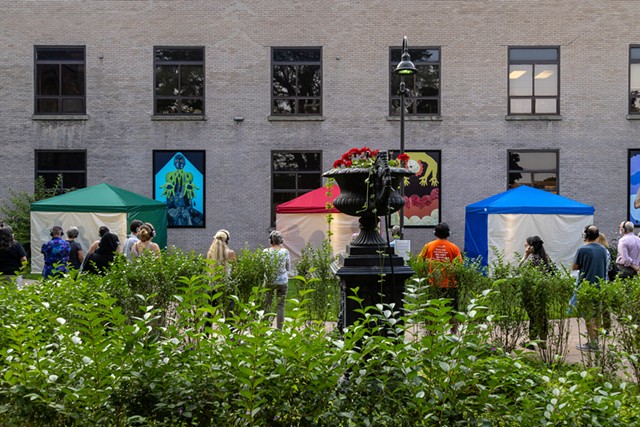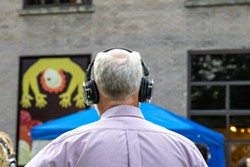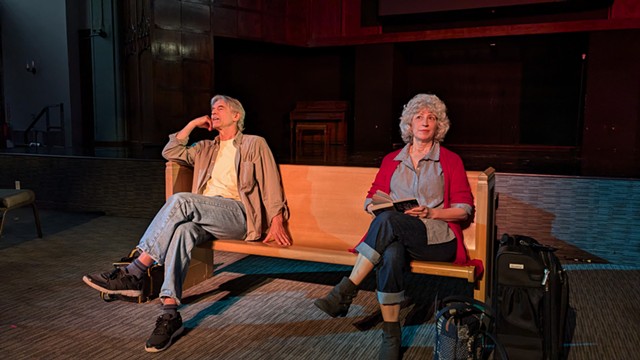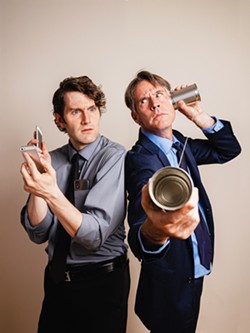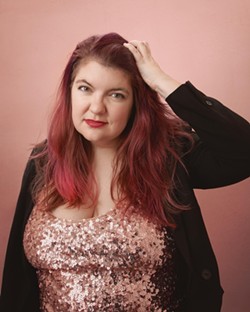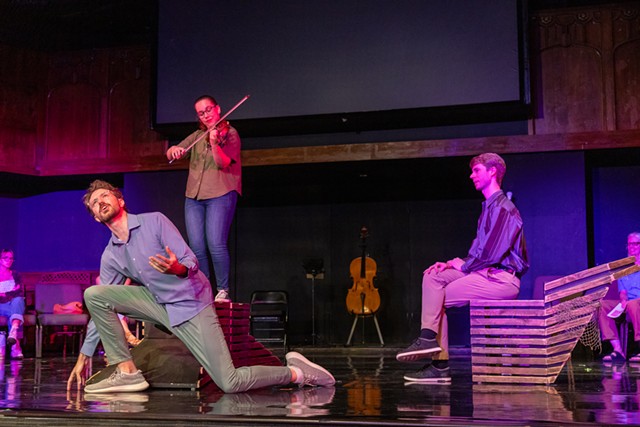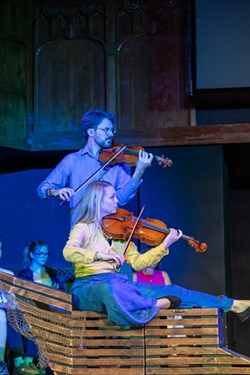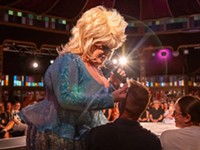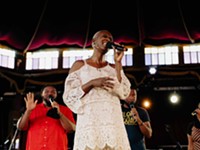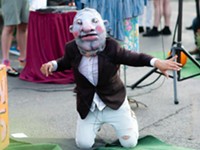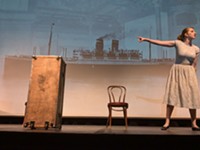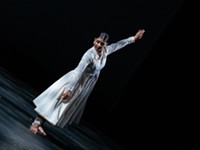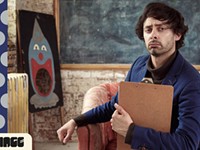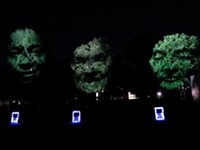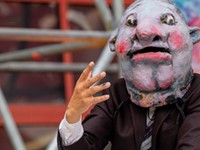[
{
"name": "500x250 Ad",
"insertPoint": "5",
"component": "15667920",
"parentWrapperClass": "",
"requiredCountToDisplay": "1"
}
]
Shadows in the tent
“Silent Reflections: A Journey Through Events that Shaped Our City” | Rochester Contemporary Art Center: Side Lawn | Sept. 14, 20, 21 | Free | All ages
The three tents that comprise “Silent Reflections” represent micro Rochester history lessons, spanning the city’s early industry to its evolving arts scene and even its legacy of racial division. The context comes from voiceover narration delivered via wireless headphones, a nice touch, while performers in the tents act out scenes behind a transparent curtain. In other words, it’s a kind of shadow play.
The performers, from MCC’s On the Edge Theatre Troupe, aim to bring the audio narrations to life. A Frederick Law Olmsted figure holds up flowers, two grist mill workers churn invisible stones and so on. The vignette discussing the Erie Canal employs mule shapes made from hand shadows — a cute touch.
But the entire enterprise is a tall order. The scripts are impressively researched but read like Wikipedia overviews, though the sonic experience of the headphones is immersive. The visual limitations of the curtain mean the actors have to make their movements big and dramatic to translate. In most cases, the actions are simply not physical enough to justify this particular presentation format.
The program succeeds when it shines light on lesser-told local history, like the civil rights uprising known as the Rochester Rebellion of 1964. Perhaps another show may go deeper on these essential, more obscure facets of the city’s identity. In the meantime, “Silent Reflections” does afford the chance to do exactly what its title suggests. —PATRICK HOSKEN
A chance encounter
“From Train to Train” | Temple Theater | Sept. 14, 15 | $15 | Ages 13+
How do you communicate an engaging drama in less than 30 minutes? That was the task for playwright Steve Duprey and his actors, Glen Wyand and Joanne Saracino, in the one-act play “From Train to Train.”
The setup was classic: two strangers cross paths at a train station, but the eventual destination of the travelers was impossible to predict from the outset. Their personalities were strikingly different. Claire, played by Saracino, was awkward, guarded and nervous. Wyand’s Kenny, by contrast, was talkative, charming and at ease.
Kenny slowly got Claire to open up about what she was searching for in life. Duprey’s script communicated a riveting story of a life filled with trauma, and in a shockingly short amount of time. But the revelation felt believable.
The subtle takeaway is that as we go through life and encounter others, we have no idea what they’ve been through. But maybe, all they need to begin the healing process is for someone to listen to them.
The chemistry between Wyand and Saracino was of the slow-burning variety, but the strength of their characters’ connection to one another always felt inevitable. “From Train to Train” proved to be the perfect pairing of brilliant writing with poignant acting. This performance is well worth it, and at only 25 minutes, you may wish it lasted longer. —DANIEL J. KUSHNER
A brother’s keeper
“Long Night of the American Dream” | CenterStage Theatre at the JCC: JCC Ballroom Stage | Sept. 15, 19, 21 | From $20 | Ages 13+
“What is America if not the story of a dysfunctional family?”
This question arrives not long into Martin Dockery’s highly meta “Long Night of the American Dream,” and an hour later, it’s clear that America — as well as the play’s two protagonists — may not actually be much of a family at all.
But the road to that takeaway is paved with funny, anxious monologues about the nature of storytelling, of raising children in an ever-toxifying world, of politics both familial and national. The personal has always been political. Dockery takes that axiom to humorous heights, with help from his co-star, Andrew Broaddus.
The Brooklyn-based performers, two mountain-faced men with broad American jaws, work wonders as estranged brothers who are actually half-brothers and who actually might not be brothers at all. Their characters are creatives on either side of the aisle — Broaddus plays the economically mobile but humanistic conservative and Dockery embodies the grounded but angry liberal — and their play-within-a-play concept is eventually taken to “Inception” levels of story nesting.
In its simplest form, “American Dream” is about trying to put seemingly insurmountable and persistent differences aside to fulfill a shared purpose. (In this case, it’s actually putting on a play.) The goal posts keep shifting and the tension keeps rising, but the two keep trying to work it out. Even when their not-so-passive aggression threatens to derail the show (within a show), they try another tale, which is a play one of them hasn’t actually read — or is it a story they both know by heart already?
Dockery’s other Fringe show, by the way, is called “The Stakeout,” again following him and Broaddus as they stake out two guys — who are also staking them out.If it all sounds too clever, that’s by design. The smart and funny “American Dream” arrives at no answer, which is, of course, the only answer that makes sense. —PATRICK HOSKEN
Can a gay girl get an amen?
“Madelein Murphy: Lesbian American Princess” | SOTA: Club SOTA | Sept. 14, 15 | $20 | Ages 16+
With a title like “Lesbian American Princess” the target audience for Rochester native Madelein Murphy’s show is pretty clear. But in case there were any doubts, the comedian's set at the intimate Club SOTA greeted audiences with a pre-show mix playing Chapell Roan, pop culture’s latest queer icon.
Opening was Kendra Dawsey from NYC, who explained she is not the titular 'Lesbian American Princess,' but still a lesbian American princess, evident by both her having a wife and a background in carpentry. Affably awkward, she warmed up the audience by describing Rochester as “cute and adorable,” clarifying “not in an offensive way!” Her set covered anecdotes from her drug dealing uncle to teaching kids about climate change, and was pleasantly engaging, if a bit choppy.
She left it to main attraction Madelein Murphy to reveal that the two are, in fact, recently married – what’s gayer than traveling to Fringe to perform comedy with your wife? Murphy, a Rochester native and SUNY Fredonia grad now living in NYC, has been honing her comedian chops for over a decade. She has both headlined and opened for several comedians, including Tig Notaro last Fringe. She thanked the audience for paying to hear her “work through my lesbian life” as she tried out material for her next album, which will be recorded in Rochester.
Her routine was chatty and casual, with occasional spurts of crowd work and pauses to consult notes in a cat notebook. Some of her jokes felt more like things she wanted to get off her chest, like a reference to the Kamala Harris campaign — “I don’t want memes, I want no genocide” — giving the night overall the feeling of catching up with your most extroverted friend.
While she graciously acknowledged the few men in the audience, her show was a love letter to lesbians, with lines like “it’s hard to be a top when you have endometriosis” and references to Provincetown, U-Haul lesbians, and going to bed at a reasonable hour. Murphy’s gregarious style is welcoming to all, but the gayer you are, the more at home you’ll feel. —KATHERINE VARGA
Giving new meaning to ‘musical theater’
“String Quartet Theatre" | Temple Theater | Sept. 14 | $25 | All ages
Rochester Fringe Festival provides a great opportunity to deconstruct familiar art forms and present them in a fresh way. And with “String Quartet Theatre,” playwright and stage director Tanner Efinger of Breadcrumbs Productions and music director Evan Meccarello of Cordancia Chamber Orchestra took the opportunity and ran with it.
The choice to remove the constrictions on both the string quartet and the audience to remain in their conventional positions was notable. Musicians moved freely about the space, sometimes venturing off on their own to go to other rooms in the building. Audience members were invited to follow the musicians, sit at seats placed on the stage and go where they wished.
This ever-shifting dynamic allowed the listener to hear certain musicians more prominently and in closer proximity than they would have in a traditional concert setting.
The other intriguing element was the expanded role of the musicians. In addition to performing the compositions, they interacted with one another dramatically, and frequently invited audience members to join them in their individual journeys. The acting performances felt natural and unrestrained, and the musicians’ dialogues with one another were loaded with both romantic and musical implications. Still, the script was vague and cryptic, leaving it open to any number of interpretations.
That said, the tension of the play centered around the quartet’s struggle to get on the same page emotionally. Violist Charlotte Malin exhibited the most pathos in her theatrical performance, while cellist Victor Minke Huls’s character was earnest and at times naive.
The musicians’ temporary separation from one another seemed to make them sound all the more in sync when they did reunite. There was an intuition to their playing, an inexplicable bond that felt stronger because their connection was hard-fought. Musically, the collective performance was on point, and the compositions ranged in style from ambient and Romantic to folk and Black spirituals.
I’d like to say that Tanner Efinger’s script imbued the music with additional meaning, but the two elements felt very separate. The absence of clear boundaries between the performers and the audience resulted in the latter being weirdly disruptive at times, although the interjections were well-intentioned.
There is no one way to experience “String Quartet Theatre,” and the story unfolds differently depending on which musicians you choose to follow. Despite those variations, the experimental nature of the performance may allow audience members to connect more directly with the musicians and the parts that they play. —DANIEL J. KUSHNER
“Silent Reflections: A Journey Through Events that Shaped Our City” | Rochester Contemporary Art Center: Side Lawn | Sept. 14, 20, 21 | Free | All ages
The three tents that comprise “Silent Reflections” represent micro Rochester history lessons, spanning the city’s early industry to its evolving arts scene and even its legacy of racial division. The context comes from voiceover narration delivered via wireless headphones, a nice touch, while performers in the tents act out scenes behind a transparent curtain. In other words, it’s a kind of shadow play.
The performers, from MCC’s On the Edge Theatre Troupe, aim to bring the audio narrations to life. A Frederick Law Olmsted figure holds up flowers, two grist mill workers churn invisible stones and so on. The vignette discussing the Erie Canal employs mule shapes made from hand shadows — a cute touch.
But the entire enterprise is a tall order. The scripts are impressively researched but read like Wikipedia overviews, though the sonic experience of the headphones is immersive. The visual limitations of the curtain mean the actors have to make their movements big and dramatic to translate. In most cases, the actions are simply not physical enough to justify this particular presentation format.
The program succeeds when it shines light on lesser-told local history, like the civil rights uprising known as the Rochester Rebellion of 1964. Perhaps another show may go deeper on these essential, more obscure facets of the city’s identity. In the meantime, “Silent Reflections” does afford the chance to do exactly what its title suggests. —PATRICK HOSKEN
A chance encounter
“From Train to Train” | Temple Theater | Sept. 14, 15 | $15 | Ages 13+
How do you communicate an engaging drama in less than 30 minutes? That was the task for playwright Steve Duprey and his actors, Glen Wyand and Joanne Saracino, in the one-act play “From Train to Train.”
The setup was classic: two strangers cross paths at a train station, but the eventual destination of the travelers was impossible to predict from the outset. Their personalities were strikingly different. Claire, played by Saracino, was awkward, guarded and nervous. Wyand’s Kenny, by contrast, was talkative, charming and at ease.
Kenny slowly got Claire to open up about what she was searching for in life. Duprey’s script communicated a riveting story of a life filled with trauma, and in a shockingly short amount of time. But the revelation felt believable.
The subtle takeaway is that as we go through life and encounter others, we have no idea what they’ve been through. But maybe, all they need to begin the healing process is for someone to listen to them.
The chemistry between Wyand and Saracino was of the slow-burning variety, but the strength of their characters’ connection to one another always felt inevitable. “From Train to Train” proved to be the perfect pairing of brilliant writing with poignant acting. This performance is well worth it, and at only 25 minutes, you may wish it lasted longer. —DANIEL J. KUSHNER
A brother’s keeper
“Long Night of the American Dream” | CenterStage Theatre at the JCC: JCC Ballroom Stage | Sept. 15, 19, 21 | From $20 | Ages 13+
“What is America if not the story of a dysfunctional family?”
This question arrives not long into Martin Dockery’s highly meta “Long Night of the American Dream,” and an hour later, it’s clear that America — as well as the play’s two protagonists — may not actually be much of a family at all.
But the road to that takeaway is paved with funny, anxious monologues about the nature of storytelling, of raising children in an ever-toxifying world, of politics both familial and national. The personal has always been political. Dockery takes that axiom to humorous heights, with help from his co-star, Andrew Broaddus.
The Brooklyn-based performers, two mountain-faced men with broad American jaws, work wonders as estranged brothers who are actually half-brothers and who actually might not be brothers at all. Their characters are creatives on either side of the aisle — Broaddus plays the economically mobile but humanistic conservative and Dockery embodies the grounded but angry liberal — and their play-within-a-play concept is eventually taken to “Inception” levels of story nesting.
In its simplest form, “American Dream” is about trying to put seemingly insurmountable and persistent differences aside to fulfill a shared purpose. (In this case, it’s actually putting on a play.) The goal posts keep shifting and the tension keeps rising, but the two keep trying to work it out. Even when their not-so-passive aggression threatens to derail the show (within a show), they try another tale, which is a play one of them hasn’t actually read — or is it a story they both know by heart already?
Dockery’s other Fringe show, by the way, is called “The Stakeout,” again following him and Broaddus as they stake out two guys — who are also staking them out.If it all sounds too clever, that’s by design. The smart and funny “American Dream” arrives at no answer, which is, of course, the only answer that makes sense. —PATRICK HOSKEN
Can a gay girl get an amen?
“Madelein Murphy: Lesbian American Princess” | SOTA: Club SOTA | Sept. 14, 15 | $20 | Ages 16+
With a title like “Lesbian American Princess” the target audience for Rochester native Madelein Murphy’s show is pretty clear. But in case there were any doubts, the comedian's set at the intimate Club SOTA greeted audiences with a pre-show mix playing Chapell Roan, pop culture’s latest queer icon.
Opening was Kendra Dawsey from NYC, who explained she is not the titular 'Lesbian American Princess,' but still a lesbian American princess, evident by both her having a wife and a background in carpentry. Affably awkward, she warmed up the audience by describing Rochester as “cute and adorable,” clarifying “not in an offensive way!” Her set covered anecdotes from her drug dealing uncle to teaching kids about climate change, and was pleasantly engaging, if a bit choppy.
She left it to main attraction Madelein Murphy to reveal that the two are, in fact, recently married – what’s gayer than traveling to Fringe to perform comedy with your wife? Murphy, a Rochester native and SUNY Fredonia grad now living in NYC, has been honing her comedian chops for over a decade. She has both headlined and opened for several comedians, including Tig Notaro last Fringe. She thanked the audience for paying to hear her “work through my lesbian life” as she tried out material for her next album, which will be recorded in Rochester.
Her routine was chatty and casual, with occasional spurts of crowd work and pauses to consult notes in a cat notebook. Some of her jokes felt more like things she wanted to get off her chest, like a reference to the Kamala Harris campaign — “I don’t want memes, I want no genocide” — giving the night overall the feeling of catching up with your most extroverted friend.
While she graciously acknowledged the few men in the audience, her show was a love letter to lesbians, with lines like “it’s hard to be a top when you have endometriosis” and references to Provincetown, U-Haul lesbians, and going to bed at a reasonable hour. Murphy’s gregarious style is welcoming to all, but the gayer you are, the more at home you’ll feel. —KATHERINE VARGA
Giving new meaning to ‘musical theater’
“String Quartet Theatre" | Temple Theater | Sept. 14 | $25 | All ages
Rochester Fringe Festival provides a great opportunity to deconstruct familiar art forms and present them in a fresh way. And with “String Quartet Theatre,” playwright and stage director Tanner Efinger of Breadcrumbs Productions and music director Evan Meccarello of Cordancia Chamber Orchestra took the opportunity and ran with it.
The choice to remove the constrictions on both the string quartet and the audience to remain in their conventional positions was notable. Musicians moved freely about the space, sometimes venturing off on their own to go to other rooms in the building. Audience members were invited to follow the musicians, sit at seats placed on the stage and go where they wished.
This ever-shifting dynamic allowed the listener to hear certain musicians more prominently and in closer proximity than they would have in a traditional concert setting.
The other intriguing element was the expanded role of the musicians. In addition to performing the compositions, they interacted with one another dramatically, and frequently invited audience members to join them in their individual journeys. The acting performances felt natural and unrestrained, and the musicians’ dialogues with one another were loaded with both romantic and musical implications. Still, the script was vague and cryptic, leaving it open to any number of interpretations.
That said, the tension of the play centered around the quartet’s struggle to get on the same page emotionally. Violist Charlotte Malin exhibited the most pathos in her theatrical performance, while cellist Victor Minke Huls’s character was earnest and at times naive.
The musicians’ temporary separation from one another seemed to make them sound all the more in sync when they did reunite. There was an intuition to their playing, an inexplicable bond that felt stronger because their connection was hard-fought. Musically, the collective performance was on point, and the compositions ranged in style from ambient and Romantic to folk and Black spirituals.
I’d like to say that Tanner Efinger’s script imbued the music with additional meaning, but the two elements felt very separate. The absence of clear boundaries between the performers and the audience resulted in the latter being weirdly disruptive at times, although the interjections were well-intentioned.
There is no one way to experience “String Quartet Theatre,” and the story unfolds differently depending on which musicians you choose to follow. Despite those variations, the experimental nature of the performance may allow audience members to connect more directly with the musicians and the parts that they play. —DANIEL J. KUSHNER
